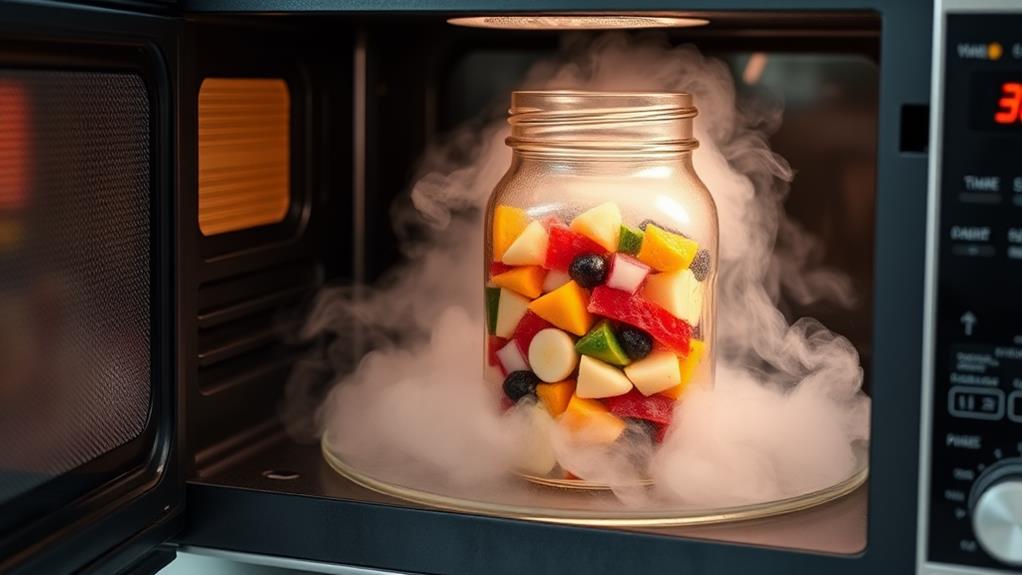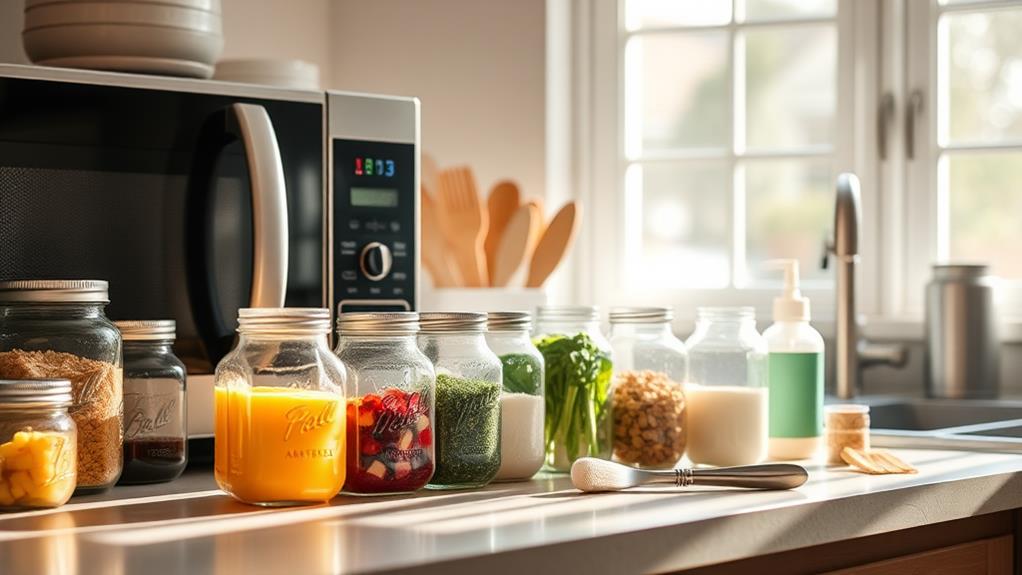You can microwave mason jars, but it's important to do it safely. First, check for a microwave-safe symbol on the jar. Always remove metal lids to prevent sparking. Allow cold jars to reach room temperature and use short heating intervals of 30 seconds to 1 minute while stirring to avoid hot spots. Fill jars only to the designated fill line to allow steam to escape. Keep an eye on them to prevent overheating. For safety, consider other heating options too. Stick around, and you'll discover more tips on how to use mason jars effectively and safely.
Microwave Safety Guidelines
When it comes to microwaving mason jars, safety is key. First, you must verify that you're using microwave-safe Mason jars. Not all jars are suitable for microwave use, so check for the microwave-safe symbol—typically a square box with wavy lines. This will confirm the jar's suitability.
Before microwaving, make sure the jar is free of metal components, such as lids and rings. Metal can cause sparking and potential hazards.
To enhance your financial organization while managing your bills, consider using tools that help track important dates and payments efficient bill tracking tools.
To minimize the risk of thermal shock, allow cold mason jars to reach room temperature before placing them in the microwave. Sudden temperature changes can crack the glass.
When you're ready to microwave, use short intervals—this helps promote even heating and allows you to monitor closely. Keep an eye on the jar to prevent overheating, which can lead to spills and messes.
Identifying Safe Mason Jars
Identifying safe mason jars for microwaving is vital to prevent accidents and guarantee your food heats evenly. Start by looking for a microwave-safe symbol on the bottom of the jar, typically a square box with wavy lines. This indicates the jar is designed to withstand thermal stress.
Make certain the jar is constructed from tempered glass, which offers better heat resistance than regular glass and minimizes the risk of breakage during the heating process. Additionally, using tools like expense tracking tools can help manage your kitchen budget effectively when purchasing supplies.
Before microwaving, always remove metal lids and rings, as these can cause sparks and create a fire hazard. It's also essential to inspect the jar for any cracks or chips. Damaged jars are more susceptible to shattering when exposed to heat or pressure, so discard any that show signs of wear.
If you're unsure about your mason jar's microwave safety, it's best to consult the manufacturer's guidelines for specific models. Following these steps guarantees you'll use a safe jar, making your microwaving experience both secure and efficient.
Best Practices for Microwaving

When microwaving mason jars, it's essential to verify they're microwave-safe by checking for the appropriate symbol on the bottom.
Some containers, like those used for expense management apps, are designed for easy heating and storage, similar to how mason jars can efficiently hold contents.
Start heating your contents in short intervals, stirring occasionally to promote even heating and prevent hot spots.
Remember to leave space for steam and always remove metal lids to avoid risks.
Microwave-Safe Jar Identification
To guarantee safe microwaving, you should always check for a safety symbol on the bottom of mason jars, as this indicates they're made of tempered glass designed to withstand thermal shock.
Using the right jar is vital for safe heating and preventing accidents. Here are some best practices for identifying microwave-safe jars:
- Look for the Safety Symbol: Verify the jar has a symbol indicating it's microwave-safe and made from tempered glass.
- Remove Metal Lids: Always take off metal lids and any decorative elements before microwaving to prevent sparking.
- Mind the Fill Line: Fill jars only to the designated fill line. This allows for expansion and prevents pressure buildup during microwaving.
- Adjust Temperature: If the jar has been stored in a cold environment, let it reach room temperature before microwaving to minimize the risk of thermal shock.
Safe Heating Techniques
Microwaving mason jars can be safe and efficient if you follow best practices for heating. First, always check for a microwave-safe symbol on your jars. Only those labeled accordingly can withstand microwave heating without risk of breakage.
Before microwaving, remove all metal components, including lids and rings, to prevent sparks and potential fires.
Use short heating intervals of 30 seconds to 1 minute, stirring the contents in between. This guarantees even heating and minimizes the risk of hot spots. When filling jars, only fill them halfway to leave room for steam expansion, which prevents pressure buildup during microwaving.
After heating, allow your jars to cool gradually outside the microwave. Never place a hot jar on a cold surface, as this can cause thermal shock and lead to breakage.
Alternatives to Microwaving
If you're looking for safe heating options, there are plenty of alternatives to microwaving mason jars.
You might want to contemplate using stovetop cooking methods or microwave-safe containers made from tempered glass. These choices not only help prevent accidents but also guarantee your food heats evenly.
Additionally, for effective financial planning, freelancers can utilize tools like expense tracking tools that help manage their budgeting and spending habits.
Safe Heating Options
When it comes to heating food, choosing the right container can make all the difference. Instead of using mason jars, consider these safer alternatives that minimize the risk of thermal shock and guarantee your meals heat evenly:
- Microwave-safe containers: Look for those made from tempered glass or ceramic to safely reheat your food without worrying about cracking or breaking.
- Slow cookers: These provide gentle, even heating, making them an excellent option for warming up meals stored in glass containers.
- Instant Pots: Versatile and efficient, Instant Pots can heat or prepare meals while keeping your food safe from the hazards of microwaving.
- Double boiler method: This technique offers gentle heating by warming food without direct heat, reducing the risk of thermal shock.
Always remember to thaw frozen contents gradually in the refrigerator or at room temperature.
Avoid using the microwave without precautions, as it can lead to dangerous breakage.
Stovetop Cooking Methods
Stovetop cooking methods offer a reliable alternative to microwaving, especially for reheating food in mason jars. These techniques, like simmering or boiling, allow you to control the heating process, reducing the risk of thermal shock that can occur in microwaves.
One effective method is using a double boiler, which gently heats the contents of the mason jar by preventing direct contact with high heat, minimizing the chance of jar breakage.
When you're reheating food in mason jars on the stovetop, keep the jar partially submerged in water. This practice guarantees even heating without overheating the glass. You can also use a pot or pan with a lid to trap steam, which helps heat the food evenly and prevents spills or splatters that are common with microwaving.
Stovetop cooking methods are particularly ideal for dishes that require longer cooking times, such as soups and stews. These methods allow for better flavor development and consistent heat distribution, making them a smart choice for safe heating and effective food storage.
Use of Containers
Finding the right container for reheating food can make all the difference in your kitchen. While you might be tempted to use mason jars, there are safer alternatives that reduce risks like breakage due to thermal shock.
Here are four options for safe containers:
- Tempered Glass or Ceramic: These materials are microwave-safe and designed to withstand high heat, minimizing the risk of breakage.
- Microwave-Safe Plastic: Lightweight and convenient, these containers are specifically designed for reheating, ensuring safety when used according to manufacturers' guidelines.
- Double Boiler Method: This technique gently heats food, avoiding direct high heat, which minimizes scorching and uneven heating.
- Slow Cookers or Instant Pots: These alternative cooking methods offer versatile options and prevent hazards associated with using mason jars in microwaves.
Care and Maintenance Tips

To keep your mason jars in top shape, clean them with warm, soapy water after each use. They're also dishwasher-safe, but be sure to check the manufacturer guidelines for specific instructions.
Regularly inspecting your jars for cracks or chips is vital, as budgeting apps can help you manage the costs associated with replacing any damaged items. Once cleaned, verify your jars are completely dry before storage to prevent mold growth. Always store them in a cool, dry place to maintain their integrity.
It's essential to regularly inspect your mason jars for cracks or chips. Damaged glass can pose a risk during use, so discard any jars that show signs of wear.
Before using jars for canning or heating, sterilize them by boiling in water or using a bleach-vinegar solution to eliminate bacteria.
Handle your jars gently to avoid breakage, and remember to allow for gradual temperature changes. Sudden shifts in temperature can lead to thermal shock, causing cracks.
Creative Uses for Mason Jars
Mason jars aren't just for canning; they can be creatively repurposed for a multitude of uses in your home.
These versatile containers add functionality and flair, making them perfect for various projects. Additionally, using Mason jars for storage can contribute to a more sustainable lifestyle by promoting sustainable packaging solutions and reducing reliance on single-use plastics.
Here are four creative uses for Mason jars:
- Meal Prep Containers: Use them to store salads, overnight oats, or parfaits. They promote healthy eating on the go while keeping your meals fresh.
- Creative Storage Solutions: Organize your pantry staples like spices, grains, and dried fruits in Mason jars. They help declutter your kitchen and make it easier to find what you need.
- Home Decor Items: Transform Mason jars into charming vases, candle holders, or miniature herb gardens. They add rustic charm to any room and can be personalized to match your decor.
- Crafting Projects: Get crafty by using Mason jars for DIY projects like snow globes, terrariums, or decorative gifts filled with homemade treats. They make unique gifts that showcase your creativity.
With these ideas, Mason jars become a stylish and functional storage option, perfect for organizing small items and enhancing your home!
Conclusion
In summary, while mason jars can be a marvelous method for microwaving, it's essential to choose the right jar and follow safety steps. By being mindful and meticulous, you can enjoy your delicious dishes without danger. Remember, the key to keeping your kitchen chaos-free is knowing when to nuke and when to avoid. So, embrace the versatility of mason jars, and let your culinary creativity shine! Safe and smart storage can spice up your meal prep!



